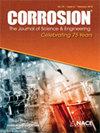激光粉末床熔合奥氏体不锈钢316L的应力腐蚀开裂行为
IF 1.1
4区 材料科学
Q4 MATERIALS SCIENCE, MULTIDISCIPLINARY
引用次数: 0
摘要
奥氏体不锈钢UNS S31603(SS316L)因其优异的耐腐蚀性、延展性和可焊性而在资源行业得到广泛应用。最近,基于激光的粉末床融合(LPBF)制造因制造具有复杂几何形状和优异机械性能的SS316L部件而广受欢迎。然而,在LPBF的热循环过程中,沉积层的快速熔化和固化会产生残余应力。通过LPBF制造的部件经常在腐蚀性环境中的外加应力下使用。因此,了解其对应力腐蚀开裂(SCC)的敏感性和残余应力的影响至关重要。本研究使用定制的C形环试样研究了外加应力和温度对LPBF SS316L应力腐蚀开裂行为的综合影响。包括冷拔锻造SS316L进行比较。应力消除热处理、显微硬度测试、部分浸渍测试和显微分析技术,如光学显微镜(LOM)、扫描电子显微镜(SEM)和电子背散射衍射(EBSD),用于量化SCC行为。这项研究的结果表明,应力和非应力LPBF SS316L试样在其印刷孔周围极易开裂。SCC敏感性归因于印刷载体引入的残余应力,因为抛光孔和印刷孔都表现出类似的开裂行为。这项工作提供了有价值的见解,并为进一步研究使用C形环样品研究应力腐蚀开裂敏感性的影响奠定了基础,并揭示了由于残余应力的影响,用支架印刷的复杂几何形状的印刷组件的应力腐蚀敏感性。本文章由计算机程序翻译,如有差异,请以英文原文为准。
Stress corrosion cracking behavior of austenitic stainless steel 316L produced using laser-based powder bed fusion
Austenitic stainless steel UNS S31603 (SS316L) is widely used in the resources industry due to its excellent corrosion resistance, ductility, and weldability. Recently, laser-based powder bed fusion (LPBF) manufacturing has gained popularity for creating SS316L components with complex geometries and superior mechanical properties. However, the rapid melting and solidification of the deposited layers during the thermal cycle of LPBF produce residual stresses. Components manufactured through LPBF are frequently used under applied stress in corrosive environments. Thus, it is crucial to understand their susceptibility to stress corrosion cracking (SCC) and the impact of residual stresses. This study investigated the combined effects of applied stress and temperature on the SCC behavior of LPBF SS316L using custom-made C-ring test specimens. Cold-drawn wrought SS316L was included for comparison. Stress relief heat treatment, microhardness testing, partial immersion testing, and microanalysis techniques, such as light optical microscopy (LOM), scanning electron microscopy (SEM), and electron backscatter diffraction (EBSD), were used to quantify the SCC behavior. The outcomes of this study showed that stressed and unstressed LPBF SS316L specimens were highly susceptible to cracking around their printed holes. The SCC susceptibility was attributed to the residual stresses introduced by the printed supports, as both polished and as-printed holes showed similar cracking behavior. This work provides valuable insights and lays a foundation for further research into the impact of using C-ring samples to investigate SCC susceptibility and sheds light on the SCC susceptibility of as-printed components of complex geometry printed with supports due to the influence of residual stresses.
求助全文
通过发布文献求助,成功后即可免费获取论文全文。
去求助
来源期刊

Corrosion
MATERIALS SCIENCE, MULTIDISCIPLINARY-METALLURGY & METALLURGICAL ENGINEERING
CiteScore
2.80
自引率
12.50%
发文量
97
审稿时长
3 months
期刊介绍:
CORROSION is the premier research journal featuring peer-reviewed technical articles from the world’s top researchers and provides a permanent record of progress in the science and technology of corrosion prevention and control. The scope of the journal includes the latest developments in areas of corrosion metallurgy, mechanisms, predictors, cracking (sulfide stress, stress corrosion, hydrogen-induced), passivation, and CO2 corrosion.
70+ years and over 7,100 peer-reviewed articles with advances in corrosion science and engineering have been published in CORROSION. The journal publishes seven article types – original articles, invited critical reviews, technical notes, corrosion communications fast-tracked for rapid publication, special research topic issues, research letters of yearly annual conference student poster sessions, and scientific investigations of field corrosion processes. CORROSION, the Journal of Science and Engineering, serves as an important communication platform for academics, researchers, technical libraries, and universities.
Articles considered for CORROSION should have significant permanent value and should accomplish at least one of the following objectives:
• Contribute awareness of corrosion phenomena,
• Advance understanding of fundamental process, and/or
• Further the knowledge of techniques and practices used to reduce corrosion.
 求助内容:
求助内容: 应助结果提醒方式:
应助结果提醒方式:


